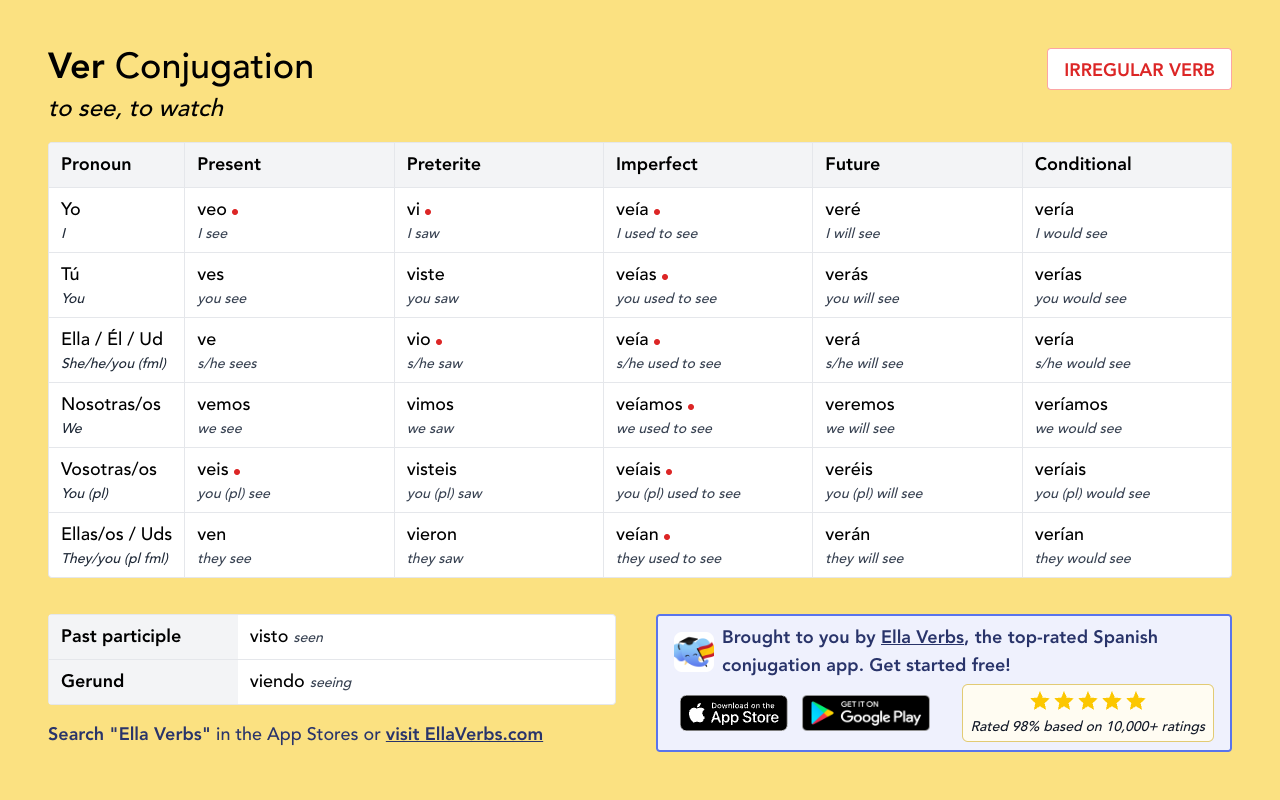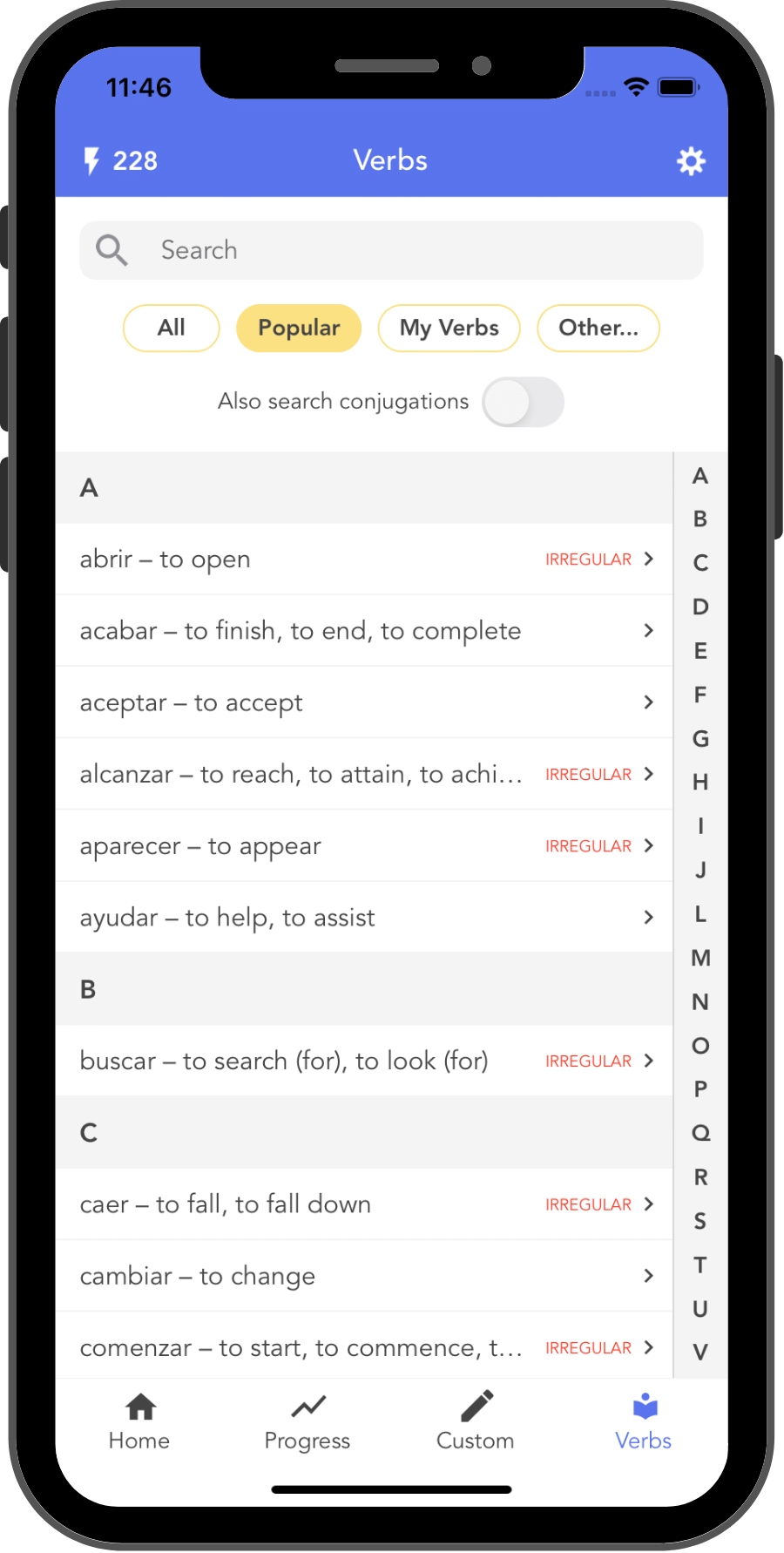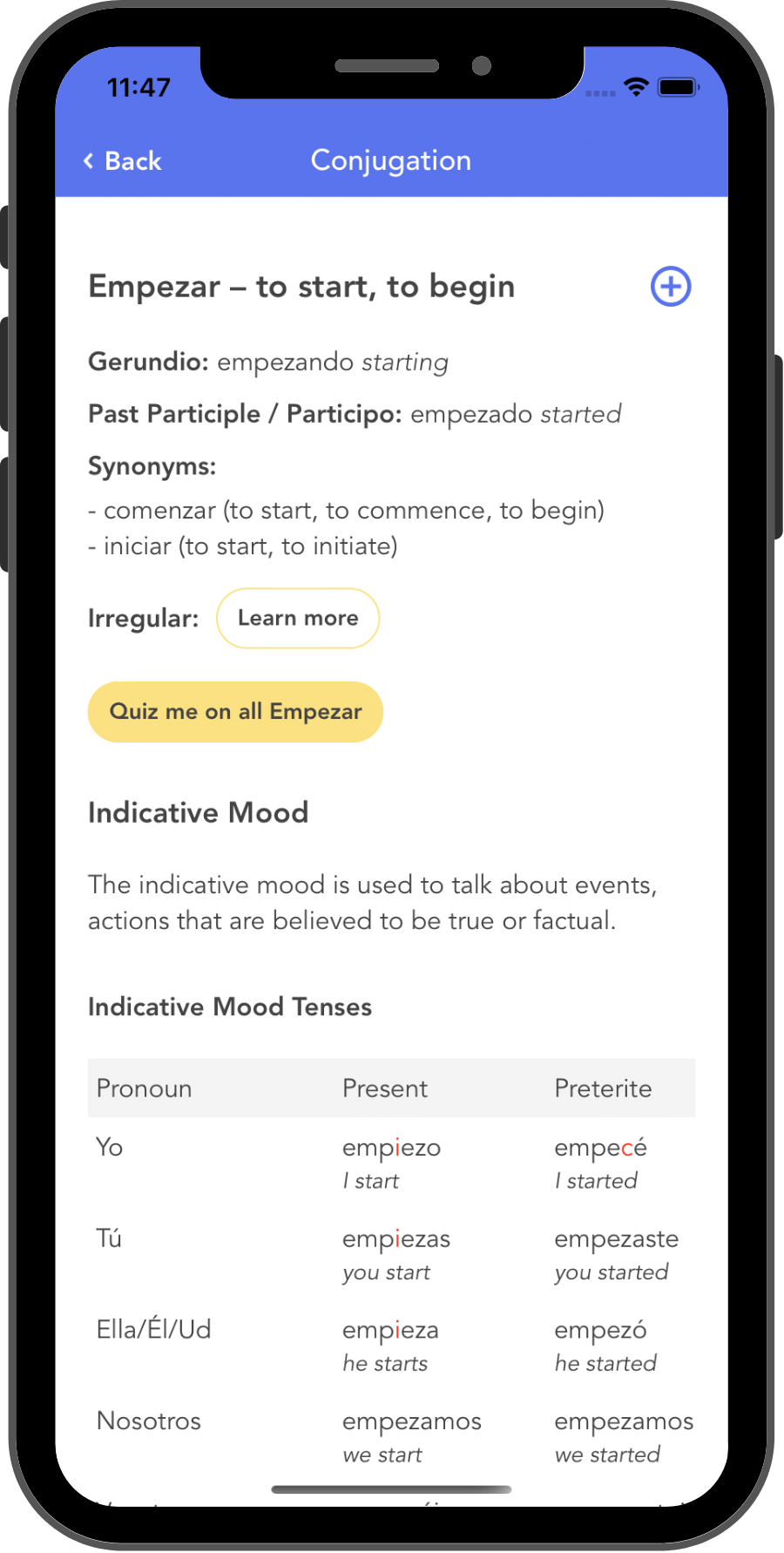 Ella Verbs
Ella VerbsHow to conjugate Ver in Spanish
To see, to watch Irregular Verb Top 100
Table of Contents
- Introduction
- Indicative tenses of Ver
- Ver in the Indicative Present
- Ver in the Indicative Preterite
- Ver in the Indicative Imperfect
- Ver in the Indicative Present Continuous
- Ver in the Indicative Informal Future
- Ver in the Indicative Future
- Ver in the Indicative Conditional
- Ver in the Indicative Present Perfect
- Ver in the Indicative Past Perfect
- Ver in the Indicative Future Perfect
- Ver in the Indicative Conditional Perfect
- Subjunctive tenses of Ver
- Imperative tenses of Ver
- Example sentences and usage
- Downloadable cheat sheet (PDF)
- Practice Ver conjugations (free mobile app)
Introduction
Ver is the Spanish verb "to see". It is mostly irregular, so endings must be learned by heart. Ver can be used for a number of reasons, the most basic "to see", for example: "Veo un coche". It can also be used to describe "watching" a movie or tv show, asking a person if they have "seen" a particular movie or object, or to notice something. E.g. Veo la diferencia entre los colores. Another helpful use of this verb is "to check". E.g. Tengo que ver cuánto tiempo me queda para hacer las compras. I have to check how much time I have left to do the shopping.
Similar verbs to ver include: echar un vistazo (to have a look at), mirar (to look at), observar (to watch).
| Item | Spanish | English |
|---|---|---|
| Infinitive | ver | to see, to watch |
| Past participle | visto | seen |
| Gerund | viendo | seeing |
Indicative Tenses of Ver
Ver in the Indicative Present
The Indicative Present of ver is used to talk about situations, events or thoughts that are happening now or in the near future. It is also used to talk about facts and truths. For example, "veo fantasmas", meaning "I see ghosts".
In Spanish, the Indicative Present is known as "El Presente".
| Pronoun | Spanish | English |
|---|---|---|
| Yo | veo | I see |
| Tú | ves | you see |
| Ella / Él / Usted | ve | s/he sees, you (formal) see |
| Nosotras / Nosotros | vemos | we see |
| Vosotras / Vosotros | veis | you (plural) see |
| Ellas / Ellos / Ustedes | ven | they see |
The red dot () above denotes an irregular conjugation.
Back to top
Ver in the Indicative Preterite
The Indicative Preterite of ver is used to talk about actions completed in the past, at a specific point in time. For example, "vi fantasmas", meaning "I saw ghosts".
In Spanish, the Indicative Preterite is known as "El Pretérito Indefinido".
| Pronoun | Spanish | English |
|---|---|---|
| Yo | vi | I saw |
| Tú | viste | you saw |
| Ella / Él / Usted | vio | s/he saw, you (formal) saw |
| Nosotras / Nosotros | vimos | we saw |
| Vosotras / Vosotros | visteis | you (plural) saw |
| Ellas / Ellos / Ustedes | vieron | they saw |
The red dot () above denotes an irregular conjugation.
Back to top
Ver in the Indicative Imperfect
The Indicative Imperfect of ver is used to describe regular and repeated actions that happened in the past and descriptions of things you used to do. For example, "veía fantasmas", meaning "I used to see ghosts".
In Spanish, the Indicative Imperfect is known as "El Pretérito Imperfecto".
| Pronoun | Spanish | English |
|---|---|---|
| Yo | veía | I used to see |
| Tú | veías | you used to see |
| Ella / Él / Usted | veía | s/he used to see, you (formal) used to see |
| Nosotras / Nosotros | veíamos | we used to see |
| Vosotras / Vosotros | veíais | you (plural) used to see |
| Ellas / Ellos / Ustedes | veían | they used to see |
The red dot () above denotes an irregular conjugation.
Back to top
Ver in the Indicative Present Continuous
The Indicative Present Continuous of ver is used to talk about something that is happening continuously or right now. For example, "estoy viendo fantasmas", meaning "I am seeing ghosts".
In Spanish, the Indicative Present Continuous is known as "El Presente Progresivo".
| Pronoun | Spanish | English |
|---|---|---|
| Yo | estoy viendo | I am seeing |
| Tú | estás viendo | you are seeing |
| Ella / Él / Usted | está viendo | s/he is seeing, you (formal) are seeing |
| Nosotras / Nosotros | estamos viendo | we are seeing |
| Vosotras / Vosotros | estáis viendo | you (plural) are seeing |
| Ellas / Ellos / Ustedes | están viendo | they are seeing |
Back to top
Ver in the Indicative Informal Future
The Indicative Informal Future of ver is used to talk about something that will happen in the future, especially in the near future. For example, "voy a ver fantasmas", meaning "I am going to see ghosts".
In Spanish, the Indicative Informal Future is known as "El Futuro Próximo".
| Pronoun | Spanish | English |
|---|---|---|
| Yo | voy a ver | I am going to see |
| Tú | vas a ver | you are going to see |
| Ella / Él / Usted | va a ver | s/he is going to see, you (formal) are going to see |
| Nosotras / Nosotros | vamos a ver | we are going to see |
| Vosotras / Vosotros | vais a ver | you (plural) are going to see |
| Ellas / Ellos / Ustedes | van a ver | they are going to see |
Back to top
Ver in the Indicative Future
The Indicative Future of ver is used to talk about something that will happen in the future. For example, "veré fantasmas", meaning "I will see ghosts".
In Spanish, the Indicative Future is known as "El Futuro Simple".
| Pronoun | Spanish | English |
|---|---|---|
| Yo | veré | I will see |
| Tú | verás | you will see |
| Ella / Él / Usted | verá | s/he will see, you (formal) will see |
| Nosotras / Nosotros | veremos | we will see |
| Vosotras / Vosotros | veréis | you (plural) will see |
| Ellas / Ellos / Ustedes | verán | they will see |
Back to top
Ver in the Indicative Conditional
The Indicative Conditional of ver is used to talk about something that may happen in the future, hypothesis and probabilities. For example, "vería fantasmas", meaning "I would see ghosts".
In Spanish, the Indicative Conditional is known as "El Condicional Simple".
| Pronoun | Spanish | English |
|---|---|---|
| Yo | vería | I would see |
| Tú | verías | you would see |
| Ella / Él / Usted | vería | s/he would see, you (formal) would see |
| Nosotras / Nosotros | veríamos | we would see |
| Vosotras / Vosotros | veríais | you (plural) would see |
| Ellas / Ellos / Ustedes | verían | they would see |
Back to top
Ver in the Indicative Present Perfect
The Indicative Present Perfect of ver is used to describe actions that started recently (in the past) and are still happening now or things that have been done recently. For example, "he visto fantasmas", meaning "I have seen ghosts".
In Spanish, the Indicative Present Perfect is known as "El Pretérito Perfecto".
| Pronoun | Spanish | English |
|---|---|---|
| Yo | he visto | I have seen |
| Tú | has visto | you have seen |
| Ella / Él / Usted | ha visto | s/he has seen, you (formal) have seen |
| Nosotras / Nosotros | hemos visto | we have seen |
| Vosotras / Vosotros | habéis visto | you (plural) have seen |
| Ellas / Ellos / Ustedes | han visto | they have seen |
The red dot () above denotes an irregular conjugation.
Back to top
Ver in the Indicative Past Perfect
The Indicative Past Perfect of ver is used to talk about actions that happened before another action in the past. For example, "había visto fantasmas", meaning "I had seen ghosts".
In Spanish, the Indicative Past Perfect is known as "El Pretérito Pluscuamperfecto".
| Pronoun | Spanish | English |
|---|---|---|
| Yo | había visto | I had seen |
| Tú | habías visto | you had seen |
| Ella / Él / Usted | había visto | s/he had seen, you (formal) had seen |
| Nosotras / Nosotros | habíamos visto | we had seen |
| Vosotras / Vosotros | habíais visto | you (plural) had seen |
| Ellas / Ellos / Ustedes | habían visto | they had seen |
The red dot () above denotes an irregular conjugation.
Back to top
Ver in the Indicative Future Perfect
The Indicative Future Perfect of ver is used to talk about something that will have happened in the future after something else has already happened. For example, "habré visto fantasmas", meaning "I will have seen ghosts".
In Spanish, the Indicative Future Perfect is known as "El Futuro Perfecto".
| Pronoun | Spanish | English |
|---|---|---|
| Yo | habré visto | I will have seen |
| Tú | habrás visto | you will have seen |
| Ella / Él / Usted | habrá visto | s/he will have seen, you (formal) will have seen |
| Nosotras / Nosotros | habremos visto | we will have seen |
| Vosotras / Vosotros | habréis visto | you (plural) will have seen |
| Ellas / Ellos / Ustedes | habrán visto | they will have seen |
The red dot () above denotes an irregular conjugation.
Back to top
Ver in the Indicative Conditional Perfect
The Indicative Conditional Perfect of ver is used to talk about something that would have happened in the past but didn’t due to another action. For example, "habría visto fantasmas", meaning "I would have seen ghosts".
In Spanish, the Indicative Conditional Perfect is known as "El Condicional Perfecto".
| Pronoun | Spanish | English |
|---|---|---|
| Yo | habría visto | I would have seen |
| Tú | habrías visto | you would have seen |
| Ella / Él / Usted | habría visto | s/he would have seen, you (formal) would have seen |
| Nosotras / Nosotros | habríamos visto | we would have seen |
| Vosotras / Vosotros | habríais visto | you (plural) would have seen |
| Ellas / Ellos / Ustedes | habrían visto | they would have seen |
The red dot () above denotes an irregular conjugation.
Back to top
Subjunctive Tenses of Ver
Ver in the Subjunctive Present
The Subjunctive Present is used to talk about situations of uncertainty, or emotions such as wishes, desires and hopes. It differs from the indicative mood due to the uncertainty of the events which are being spoken about. For example, "vea", meaning "I see".
In Spanish, the Subjunctive Present is known as "El Presente de Subjuntivo".
| Pronoun | Spanish | English |
|---|---|---|
| Yo | vea | I see |
| Tú | veas | you see |
| Ella / Él / Usted | vea | s/he sees, you (formal) see |
| Nosotras / Nosotros | veamos | we see |
| Vosotras / Vosotros | veáis | you (plural) see |
| Ellas / Ellos / Ustedes | vean | they see |
The red dot () above denotes an irregular conjugation.
Back to top
Ver in the Subjunctive Imperfect
The Subjunctive Imperfect is used to speak about unlikely or uncertain events in the past or to cast an opinion (emotional) about something that happened in the past. For example, "viera", meaning "I saw".
In Spanish, the Subjunctive Imperfect is known as "El Imperfecto Subjuntivo".
| Pronoun | Spanish | English |
|---|---|---|
| Yo | viera | I saw |
| Tú | vieras | you saw |
| Ella / Él / Usted | viera | s/he saw, you (formal) saw |
| Nosotras / Nosotros | viéramos | we saw |
| Vosotras / Vosotros | vierais | you (plural) saw |
| Ellas / Ellos / Ustedes | vieran | they saw |
Back to top
Ver in the Subjunctive Future
The Subjunctive Future is used to speak about hypothetical situations, and actions/events that may happen in the future. For example, "viere", meaning "I will see".
In Spanish, the Subjunctive Future is known as "El Futuro de Subjuntivo".
| Pronoun | Spanish | English |
|---|---|---|
| Yo | viere | I will see |
| Tú | vieres | you will see |
| Ella / Él / Usted | viere | s/he will see, you (formal) will see |
| Nosotras / Nosotros | viéremos | we will see |
| Vosotras / Vosotros | viereis | you (plural) will see |
| Ellas / Ellos / Ustedes | vieren | they will see |
Back to top
Ver in the Subjunctive Present Perfect
The Subjunctive Present Perfect is used to describe past actions or events that are still connected to the present day and to speak about an action that will have happened by a certain time in the future. For example, "haya visto", meaning "I have seen".
In Spanish, the Subjunctive Present Perfect is known as "El Pretérito Perfecto de Subjuntivo".
| Pronoun | Spanish | English |
|---|---|---|
| Yo | haya visto | I have seen |
| Tú | hayas visto | you have seen |
| Ella / Él / Usted | haya visto | s/he has seen, you (formal) have seen |
| Nosotras / Nosotros | hayamos visto | we have seen |
| Vosotras / Vosotros | hayáis visto | you (plural) have seen |
| Ellas / Ellos / Ustedes | hayan visto | they have seen |
The red dot () above denotes an irregular conjugation.
Back to top
Ver in the Subjunctive Past Perfect
The Subjunctive Past Perfect is used to speak about hypothetical situations, and actions/events that occurred before other actions/events in the past. For example, "hubiera visto", meaning "I had seen".
In Spanish, the Subjunctive Past Perfect is known as "El Pretérito Pluscuamperfecto de Subjuntivo".
| Pronoun | Spanish | English |
|---|---|---|
| Yo | hubiera visto | I had seen |
| Tú | hubieras visto | you had seen |
| Ella / Él / Usted | hubiera visto | s/he had seen, you (formal) had seen |
| Nosotras / Nosotros | hubiéramos visto | we had seen |
| Vosotras / Vosotros | hubierais visto | you (plural) had seen |
| Ellas / Ellos / Ustedes | hubieran visto | they had seen |
The red dot () above denotes an irregular conjugation.
Back to top
Ver in the Subjunctive Future Perfect
The Subjunctive Future Perfect is used to speak about something that will have happened if a hypothetical situations occurs in the future. For example, "hubiere visto", meaning "I will have seen".
In Spanish, the Subjunctive Future Perfect is known as "El Futuro Perfecto de Subjuntivo".
| Pronoun | Spanish | English |
|---|---|---|
| Yo | hubiere visto | I will have seen |
| Tú | hubieres visto | you will have seen |
| Ella / Él / Usted | hubiere visto | s/he will have seen, you (formal) will have seen |
| Nosotras / Nosotros | hubiéremos visto | we will have seen |
| Vosotras / Vosotros | hubiereis visto | you (plural) will have seen |
| Ellas / Ellos / Ustedes | hubieren visto | they will have seen |
The red dot () above denotes an irregular conjugation.
Back to top
Imperative Tenses of Ver
Ver in the Imperative Affirmative
The Imperative Affirmative is used to give orders and commands, to tell someone to do something. For example, "vea", meaning "(to you formal) see!".
In Spanish, the Imperative Affirmative is known as "El Imperativo Afirmativo".
| Pronoun | Spanish | English |
|---|---|---|
| Yo | - | - |
| Tú | ve | (to you) see! |
| Ella / Él / Usted | vea | (to you formal) see! |
| Nosotras / Nosotros | veamos | let's see! |
| Vosotras / Vosotros | ved | (to you plural) see! |
| Ellas / Ellos / Ustedes | vean | (to you plural formal) see! |
The red dot () above denotes an irregular conjugation.
Back to top
Ver in the Imperative Negative
The Imperative Negative is used to give orders and commands, telling someone not to do something. For example, "no vea", meaning "(to you formal) don't see!".
In Spanish, the Imperative Negative is known as "El Imperativo Negativo".
| Pronoun | Spanish | English |
|---|---|---|
| Yo | - | - |
| Tú | no veas | (to you) don't see! |
| Ella / Él / Usted | no vea | (to you formal) don't see! |
| Nosotras / Nosotros | no veamos | let's not see! |
| Vosotras / Vosotros | no veáis | (to you plural) don't see! |
| Ellas / Ellos / Ustedes | no vean | (to you plural formal) don't see! |
The red dot () above denotes an irregular conjugation.
Back to top
Example sentences and usage
- Hay un problema que no ves. There's a problem there that you don't see.
- Si ves un error, entonces corrígelo, por favor. If you see a mistake, then please correct it.
- No vemos las cosas según son, sino según somos. We don't see things as they are, but as we are.
- Ve y habla con mi compañero. Go and speak to my colleague.
- Te ves muy pálido. You look very pale.
- Te ves muy encantador hoy. You look very charming today.
- Te ves muy cansado. You look very tired.
- Te ves como tu padre hace treinta años. You look the way your father did thirty years ago.
Back to top
Downloadable cheat sheets
Download and print a cheat sheet of Ver Spanish conjugation tables in image or PDF format:

Back to top
Practice Ver conjugations (free mobile & web app)
Get full conjugation tables for Ver and 2,300+ other verbs on-the-go with Ella Verbs for iOS, Android, and web.
We also guide you through learning all Spanish tenses and test your knowledge with conjugation quizzes. Download it for free!


Back to top
About Ella Verbs
👋 Hola! We built Ella Verbs to help people (and ourselves!) master one of the hardest parts of Spanish – verb conjugation. It guides you through learning all tenses in an easy-to-follow way, giving you levels of bite-sized lessons and fun quizzes. Here is a 6 minute overview of all of the app's features:
It has changed a lot over the 6+ years we have been working on it, but the goal remains the same – to help you master Spanish conjugation! You can download and try it for free, and, if you do, please send any and all feedback our way!
- Jane & Brian
Back to top
Want to explore other verb conjugations?
Why not check out Verificar – to verify or see the complete list of verbs here.
Back to top
Ver: to see, to watch
Remove the mystery behind Spanish conjugation with Ella Verbs
- Learn how to conjugate (not just memorize)
- Discover & focus on your weaknesses
- Interactive quizzes that you actually learn from
- Free to try, and free forever for those who cannot afford it.
